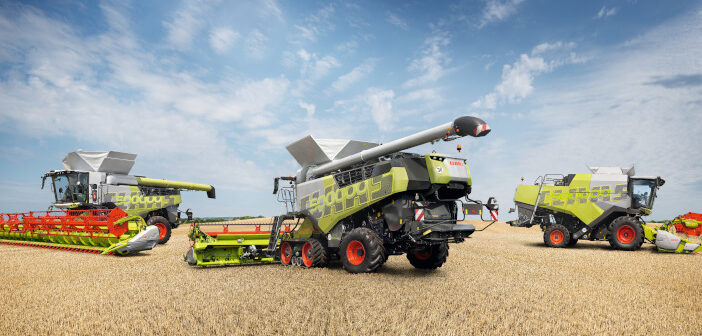Claas is celebrating the production of its 500,000th combine harvester since launching the product range in 1936.
To celebrate the company is producing several anniversary machines from the Lexion, Trion, Evion and Dominator product lines at three locations, on three continents.
The family business introduced the mowing-threshing binder with the cross-flow principle (MDB) in 1936, before following this a decade later with the Super series, which brought great success.
In 1953, the Super could be specified with an add-on engine, and in 1958, Claas introduced a hydraulic cutting unit drive on the Super Automatic. Throughout its production, more than 60,000 units of the Super were marketed.
Self-propelled machines were introduced in 1953 with the Hercules, which was later rebranded as the SF. Then, in 1961, the Matador Gigant extended the cutting width of combine harvesters to 6m.
Perhaps the company’s best-known harvester is the Dominator, which was introduced in 1972 and continues to be offered in certain markets. It introduced three-dimensional cleaning, Auto Contour cutterbar guidance and the Mega threshing unit.
When the Dominator CS with cylinder separation was introduced in 1981, it was among the most powerful harvesters in the world and was the first to be offered with rubber tracks.
In 1995, Agritechnica saw the introduction of the Lexion 480, fitted with APS hybrid technology, and featuring electronic applications for early precision farming. It has been offered with the Terra Trac system since 1997.
Significant Dominator and Lexion sales
Of the half million combines sold, Dominator and Lexion machines account for the largest share, with around 100,000 and 75,000 produced respectively. Another 65,000 come from the Super and Super Automatic range, matched by the combined total of Europa and Columbus machines.
The Tucano represents around 35,000 units, but series that were built in smaller numbers – such as the Commander Terra Trac – also had an impact on the development of today’s machines.
There are also units developed abroad, including the Crop Tiger which is produced in India, with 10,000 manufactured. The company also has a facility in Omaha, producing Lexion combines in Caterpillar branding until 2019 and now in the Claas livery.
In China, the takeover of Jinyee has led to the production of Dominator 370 hybrid and 260 straw walker machines, alongside the latest Evion combines. Claas also develops cutting heads, with a factory in Törökszentmiklós, Hungary.
Anniversary machines
To celebrate the 500,000 combines produced, several machines have been built with a special look and will be on display at various national and international trade fairs.
The design is a homage to the product history, with metallic silver representing the very beginning, metallic seed green for the well-known livery introduced in 1961, and a knotting pattern in the logo, harking back to the company’s first design.
“500,000 CLAAS combine harvesters are, above all, 500,000 success stories, because farmers and contractors worldwide have placed their trust in us 500,000 times,” explains Jan-Hendrik Mohr, Claas CEO.
“We are therefore celebrating this unit anniversary internationally with a global roll-out of several anniversary machines in Harsewinkel, Omaha and Gaomi. This also reflects and appreciates our international competence and production network for combine harvesters, which of course also includes our production site for cutterbars and corn pickers in Törökszentmiklos, Hungary.”
A special sales edition will be produced, with selected options included and ‘More than a machine’ stickers on the side panels. All models this year will also feature a small sticker on the cabin door.




